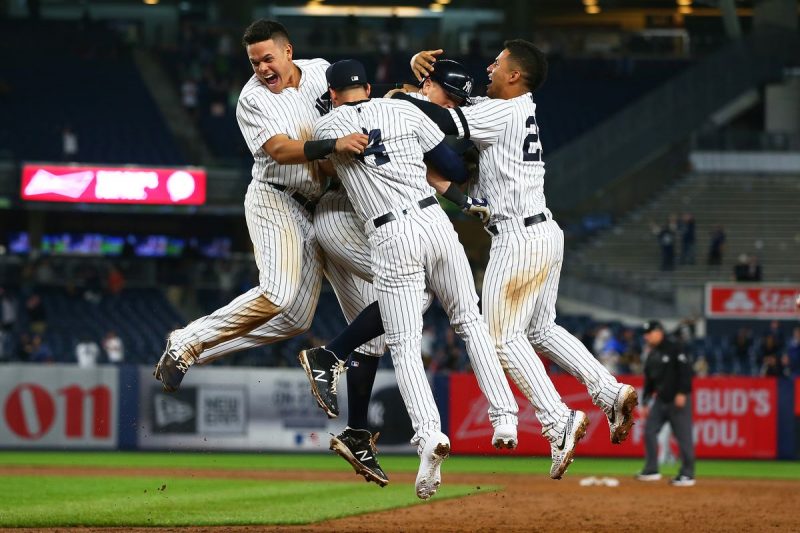The Yankees won 95 games and the division in 2012. Yet in 2013, they had a 10-game drop off finishing the year at 85-78. That is the year the team paced the league with 28 disabled list stints that amounted to a total of nearly 1,500 DL days.
The 2019 team has, of course, already faced their fair share of injuries , yet the reserves are holding down the fort with reinforcements on the way. This year’s team has definitely been more exciting and energetic. This makes sense given that the average age of the 2013 team was 32.0 versus this year’s average of 27.6. Let’s dive into comparing these two teams.
Hitters
I think a good way to succinctly summarize that 2013 season is by looking at the Opening Day lineup from 2013 (top). The lineup below that is from earlier this season.
Brett Gardner, CF
Eduardo Nunez, SS
Robinson Cano, 2B
Kevin Youkilis, 1B
Vernon Wells, LF
Ben Francisco, DH
Ichiro Suzuki, RF
Jayson Nix, 3B
Francisco Cervelli, C
DJ LeMahieu, 2B
Luke Voit, DH
Brett Gardner, CF
Clint Frazier, RF
Mike Tauchman, LF
Gio Urshela, 3B
Mike Ford, 1B
Austin Romine, C
Tyler Wade, SS
Not only is Gardner the only player still on the Yankees from that 2013 lineup, but five of those guys are no longer in the league. The team also had guys like Lyle Overbay (142 games) and Travis Hafner (82 games) play a lot. In total, there were 33 different position players who got a shot that year. So far in 2019, that number is 19.
In terms of specific stats, there were some head-scratchers leading a variety of categories if you take out Cano. For example, Alfonso Soriano only played in 58 games after being acquired via trade but was second in homers with 17. Following him were Overbay (14), Hafner (12), and Wells (11). Here are other leaders (again, sans Cano):
| STAT | PLAYER | VALUE |
| RBI | Overbay | 59 |
| OPS | Gardner | .759 |
| WAR | Gardner | 4.3 |
Sure, Gardner had a good year, but injuries limited key players such as Mark Teixeira, Derek Jeter, and Curtis Granderson to a combined 93 games. And let’s face it – this year’s squad has a lot more cumulative talent when whole than the 2013 team had. So even when you’re missing Aaron Judge, Giancarlo Stanton, and Didi Gregorius you still have Gary Sanchez, Gleyber Torres, and DJ LeMahieu in the lineup.
Pitchers
I’m not sure how the Japanese players do it, but they find a way to stay on the field. Behind Cano, Ichiro played the most games in 2013 with 150, at the ripe age of 39. Hiroki Kuroda, age 38, was tied for the most starts with 32. Even look at Masahiro Tanaka – many didn’t think he could pitch through a partial UCL tear but he’s still standing.
2013 was CC Sabathia’s first down year, as he finished with a 4.78 ERA. In addition to Sabathia and Kuroda, the rotation was rounded out by the likes of Phil Hughes, Ivan Nova, David Phelps, and the one and only Andy Pettitte. The issue here wasn’t so much with injuries, it was just that the pitching staff lacked talent. However, they still found a way to rank eight in the AL in ERA.
This year has seen key starters James Paxton and Luis Severino go down. Yet Domingo German has emerged. Jonathan Loaisiga has been solid as well.
Conclusion
The 2013 team was 19-13 through May 8. This year’s team: 21-15.The important thing to realize when comparing the two teams is the age factor.
While the winning percentages through May 8 are comparable, this year’s team is much younger. You don’t have Cashman fishing to try and wring out whatever’s left of aging veterans – rather, you have him taking flyers on young talent that was given up on. Overbay was 36, Wells was 34, and Hafner was 36. Luke Voit is 28, Gio Urshela is 27, and Clint Frazier is 24. Sure Frazier wasn’t necessarily a diamond in the rough, but what would have been his fate if he was a prospect in 2013? His prior prospect ranking and injury history could have made him a centerpiece in a deal to find an older, more accomplished player.
Another thing that is different is the use of analytics. There is no denying that the field has burgeoned in the time between these two seasons, which has allowed Cashman and company to truly identify buy-low players.
These aspects make me believe that the 2019 Yankees are more sustainable than their 2013 counterparts. Sure, they have much more talent on the way when healthy, but the team is younger, hungrier, and fighting for their jobs. In 2013, the Yankees had a -21 run differential. This year, that figure is currently at +32.
The 2013 squad went into the All-Star break seven games over .500 but they were just one game over in the second half. Let’s see how this year ends up, but I don’t anticipate there being a drop-off.




